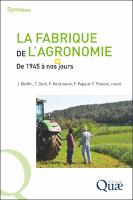La fabrique de l'agronomie
De 1945 à nos jours
Contributor(s)
Boiffin, Jean (editor)
Doré, Thierry (editor)
Kockmann, François (editor)
Papy, François (editor)
Prévost, Philippe (editor)
Language
FrenchAbstract
Since the Second World War, agronomy has become a scientific and technical discipline in its own right, supporting the reasoning behind plant production practices. Initially conceived as an application of agricultural chemistry and plant physiology, it has developed its own concepts and extended its field by integrating knowledge from many other disciplines. It has also developed by studying the practices of farmers and other rural actors. These developments have enabled it to renew its usefulness, by responding to the new challenges that agriculture is constantly facing. How did this construction take place? What were the processes, stages and actors involved? By analysing the way in which agronomy has been shaped in France, from the middle of the 20th century to the present day, La Fabrique de l'agronomie aims to shed light on the future and to stimulate useful reflection on the conditions for its development in the coming decades. This book on the evolution of the discipline is intended for agronomists of all professions who are faced with the challenges of the future, whether they are students, working or retired.
Keywords
farmer; agriculture; agronomy; teaching; history; public policy; research; farming systemDOI
10.35690/978-2-7592-3542-1ISBN
9782759235414, 9782759235421, 9782759235438, 9782759235414Publisher
éditions QuaePublication date and place
2022Classification
Agronomy and crop production


 Download
Download